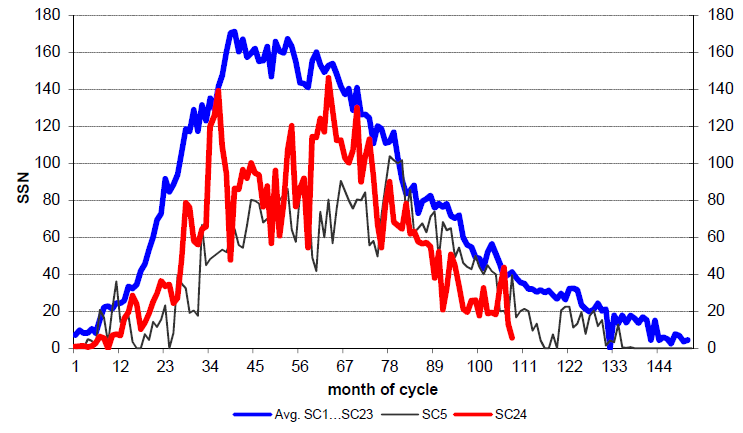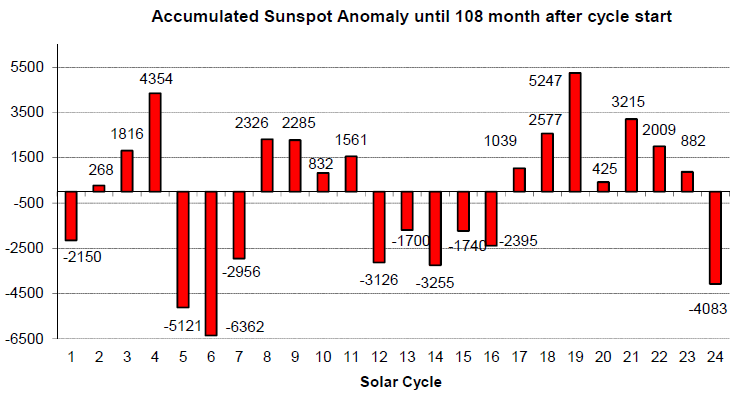The Sun in November 2017
By Frank Bosse and Prof. Fritz Vahrenholt
(Translated and edited by P Gosselin)
In November the sun was unusually quiet with respect to activity. The observed sunspot number (SSN) was merely 5.7, which is only 14% of what is typically normal for month number 108 into the cycle. The current cycle number 24 began in December 2008. The sun was completely spotless 19 of 30 days in November.
At the end of the month some activity appeared, but only at a very low level. The following chart depicts the current cycle’s activity:

Figure 1: The monthly SSN values for the current solar cycle 24 (red) 108 months into the cycle, the curve for the mean of the previous 23 cycles (blue), and the similar solar cycle number 5 (black).
The next chart shows a comparison of all observed solar cycles thus far:

Figure 2: The monthly accumulated anomalies of the cycles up to 108 months into the cycle. Cycle number 24 has taken third place for the most inactive.
The situation thus remains unchanged: such a weak solar cycle has not been witnessed in 200 years. It is anticipated with quite high certainty that also the upcoming solar cycle number 25 will be about as weak, because the sun’s polar fields are about as strong as they were during the minimum between cycle number 23 and cycle number 24.
The very weak solar north pole so far has recovered significantly over the past few months since June. What this means now and for the future can be seen graphically at the chart posted here. You can find the latest information at www.solen.info/solar.
LaNina is here
An update to our last post here is surely of interest. We were sure of a La Nina by the end of December, and in the meantime the Australian Bureau of Meteorology officially announced a La Nina in its most recent bulletin. The current model forecast shows continued falling sea surface temperatures along the equatorial eastern Pacific until about February, 2018:

Figure 3: The model for El Nino/La Nina in the Pacific, Source: NOAA. All forecasts point to a moderately strong La Nina event until spring. A powerful La Nina such as the one observed in 2011/12 is currently not projected by the models (which incidentally did not even forecast a La Nina just a few months ago).
The impacts on global temperatures lag behind by about 3 to 4 months, and so we should expect a La Nina dip by spring.





Shouldn’t it read ?…a la Nina dip by Autumn ( march april may) in OZ
That’s the sort of reasoning one gets from being up-side-down.
ʍǝ ɐɹǝ uoʇ ndsᴉpǝ poʍu ¡
Lololol
But if you are in an upside down country and you do a headstand are you upright?
La Nina forming.
http://www.ospo.noaa.gov/data/sst/anomaly/2017/anomnight.12.11.2017.gif
I just think we are all just messing around too much worrying about the weather and what if anything is actually causing so called AGW that we( as humanity) should just tell that Sun God person to turn the flares and spots down a fraction.